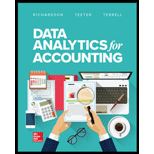
Data Analytics For Accounting
19th Edition
ISBN: 9781260375190
Author: RICHARDSON, Vernon J., Teeter, Ryan, Terrell, Katie
Publisher: Mcgraw-hill Education,
expand_more
expand_more
format_list_bulleted
Question
Chapter 6, Problem 3MCQ
To determine
Identify the characteristics of the monetary unit sampling from the given options.
Expert Solution & Answer
Want to see the full answer?
Check out a sample textbook solution